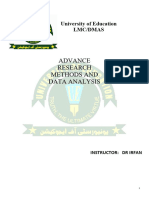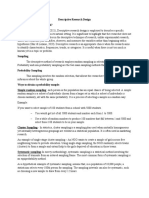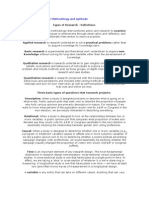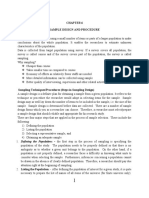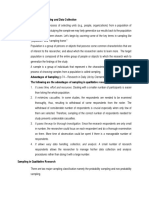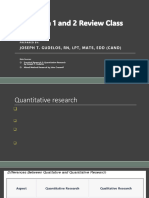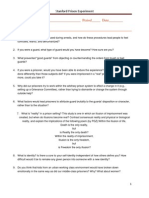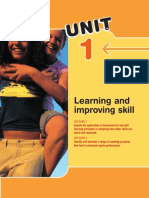0 ratings0% found this document useful (0 votes)
19 viewsResearch Design Example
Research Design Example
Uploaded by
Jay TabuelogResearch design is a plan or blueprint for how a study will be conducted to answer the research question. It outlines the procedures for collecting and analyzing data. Research methodology refers to the specific techniques or methods used to identify, select, process and analyze information, such as surveys, experiments, or interviews. An exploratory study aims to explore a topic with little prior research and inform future research design, while a research article example used random sampling and surveys to study the impact of a job support program on mental health and well-being.
Copyright:
© All Rights Reserved
Available Formats
Download as PDF, TXT or read online from Scribd
Research Design Example
Research Design Example
Uploaded by
Jay Tabuelog0 ratings0% found this document useful (0 votes)
19 views2 pagesResearch design is a plan or blueprint for how a study will be conducted to answer the research question. It outlines the procedures for collecting and analyzing data. Research methodology refers to the specific techniques or methods used to identify, select, process and analyze information, such as surveys, experiments, or interviews. An exploratory study aims to explore a topic with little prior research and inform future research design, while a research article example used random sampling and surveys to study the impact of a job support program on mental health and well-being.
Original Title
aRT
Copyright
© © All Rights Reserved
Available Formats
PDF, TXT or read online from Scribd
Share this document
Did you find this document useful?
Is this content inappropriate?
Research design is a plan or blueprint for how a study will be conducted to answer the research question. It outlines the procedures for collecting and analyzing data. Research methodology refers to the specific techniques or methods used to identify, select, process and analyze information, such as surveys, experiments, or interviews. An exploratory study aims to explore a topic with little prior research and inform future research design, while a research article example used random sampling and surveys to study the impact of a job support program on mental health and well-being.
Copyright:
© All Rights Reserved
Available Formats
Download as PDF, TXT or read online from Scribd
Download as pdf or txt
0 ratings0% found this document useful (0 votes)
19 views2 pagesResearch Design Example
Research Design Example
Uploaded by
Jay TabuelogResearch design is a plan or blueprint for how a study will be conducted to answer the research question. It outlines the procedures for collecting and analyzing data. Research methodology refers to the specific techniques or methods used to identify, select, process and analyze information, such as surveys, experiments, or interviews. An exploratory study aims to explore a topic with little prior research and inform future research design, while a research article example used random sampling and surveys to study the impact of a job support program on mental health and well-being.
Copyright:
© All Rights Reserved
Available Formats
Download as PDF, TXT or read online from Scribd
Download as pdf or txt
You are on page 1of 2
1. What do you mean by research design?
Differentiate between research methodology
and research design. Illustrate your answer with suitable example
Research design is a mapping strategy. It is essentially a statement of the object of the
inquiry and the strategies for collecting the evidence, analyzing the evidence and
reporting the findings. On the other hand, research methodology is the specific
procedures or techniques used to identify, select, process, and analyze information
about a topic. In a research paper, the methodology section allows the reader to critically
evaluate a study's overall validity and reliability.
Research Design Example:
Exploratory research is conducted when enough is not known about a phenomenon and
a problem that has not been clearly defined (Saunders et al., 2007). It does not aim to
provide the final and conclusive answers to the research questions, but merely explores
the research topic with varying levels of depth. Therefore, its theme is to tackle new
problems on which little or no previous research has been done (Brown, 2006). Even in
the extreme case, exploratory research forms the basis for more conclusive research
and determines the initial research design, sampling methodology and data collection
method (Singh, 2007).
Research Methodology Example:
This research article discusses the psychological and emotional impact of a mental
health support program for employees. The program provided prolonged and tailored
help to job seekers via a job support agency that kept contact with applicants beyond
initial job placement to give different forms of assistance. I chose a 50% random
selection of respondents who participated in the employment agency's support program
between April and October and met the research criteria I created based on prior and
comparable studies.
We discovered that, rather than demonstrating better functioning and higher self-esteem,
participants in the therapy group exhibited poorer cognitive and emotional functioning
and self-esteem. These findings prompted my study team and me to conclude that
people who consider themselves unfulfilled in their jobs often endure a substantial
decline in performance as a consequence of increased workplace stress and lower
emotional well-being, irrespective of their mental health status.
2. Enumerate the characteristics of good research design and indicate potential problems
in preparing a research design.
- Reliability
- Validity
- Generalized
- Neutrality
3. Define the term ‘Sampling’. Differentiate between sample and population and illustrate
your answer with examples.
Sampling is an indispensable technique of behavioral research, the research work
cannot be undertaken without use of sampling. The study of the total population is not
possible and it is also impracticable. The practical limitation: cost, time and other factors
which are usually operative in the situation, stand in the way of studying the total
population. Population means the respondents characteristics such as academic
attainment, gender, and age. Sample on the other hand involves designs such as
random, stratified and else.
4. Distinguish between probability sampling and non-probability sampling. Mention the
assumptions of a probability sampling.
Probability sampling refers to the selection of a sample from a population, when this
selection is based on the principle of randomization, that is, random selection or chance.
Probability sampling is more complex, more time-consuming and usually more costly
than non-probability sampling. Non-probability sampling is a method of selecting units
from a population using a subjective (i.e. non-random) method. Since non-probability
sampling does not require a complete survey frame, it is a fast, easy and inexpensive
way of obtaining data. A common assumption across all inferential statistical tests is that
you collected data from a random sample from your population of interest. To be a truly
random sample, every subject in your target population must have an equal chance of
being selected in your sample
5. What do you mean by the term ‘Randomization’? Indicate the methods of randomization
and their advantages and limitations.
Randomization is a method of sampling in which each individual of the population has
the equal chance or probability of selection of the individuals for constituting a sample.
The choice of one individual is in no way tied with another. The individuals of a sample
are independently drawn from the population. All members of the population have
essentially the same probability of being selected. The following are main methods of
randomization: (a) Lottery method of randomization. (b) Tossing a coin (Head or tail)
method. (c) Throwing a dice. (d) Blind folded method. (e) Random tables (Tiptt’s Table of
Randomization).
You might also like
- CV Notes PDFDocument206 pagesCV Notes PDFthomasNo ratings yet
- Research Methods: Simple, Short, And Straightforward Way Of Learning Methods Of ResearchFrom EverandResearch Methods: Simple, Short, And Straightforward Way Of Learning Methods Of ResearchRating: 4 out of 5 stars4/5 (13)
- Rma ReviewerDocument7 pagesRma ReviewerPatricia de los SantosNo ratings yet
- PR2 Lesson 1Document5 pagesPR2 Lesson 1Marcco Juan MarccoNo ratings yet
- Thesis Sampling TechniqueDocument6 pagesThesis Sampling TechniqueKarla Adamson100% (2)
- 5 Quantitative Data CollectionDocument18 pages5 Quantitative Data CollectionfatemehNo ratings yet
- UntitledDocument16 pagesUntitledPauleen Vivien FabiaNo ratings yet
- Chapter Three MethodologyDocument5 pagesChapter Three MethodologyKwame NyarkoNo ratings yet
- Qualitative Research DesignDocument28 pagesQualitative Research DesignenriquezlujilleanndNo ratings yet
- ResearchDocument4 pagesResearchKriza EstocadoNo ratings yet
- PR 1 4TH QTR ReviewerDocument8 pagesPR 1 4TH QTR ReviewerVinz AlilingNo ratings yet
- Assignment No 2: Answer: Strengths of Quantitative ResearchDocument12 pagesAssignment No 2: Answer: Strengths of Quantitative Researchحارث میوNo ratings yet
- Chapter IIIDocument19 pagesChapter IIIAleia ConstanteNo ratings yet
- Shoeb Ahmedassignmentfor Gopinath Reddy SirDocument14 pagesShoeb Ahmedassignmentfor Gopinath Reddy SirLiaquat RaniaNo ratings yet
- Research Methodology ProjectDocument8 pagesResearch Methodology ProjectdeekshaNo ratings yet
- Final Notes Advance Research MethodsDocument14 pagesFinal Notes Advance Research MethodsMuhammad AsifNo ratings yet
- MethodologyDocument6 pagesMethodologyYuri PamaranNo ratings yet
- Brent Research AssignmentDocument24 pagesBrent Research AssignmentBrent Mathew NofuenteNo ratings yet
- Finals - ReviewerDocument17 pagesFinals - ReviewerCharmy Rose FranciscoNo ratings yet
- MEM-RM-Lec. 05.1Document48 pagesMEM-RM-Lec. 05.1Samah RadmanNo ratings yet
- Descriptive HEHSzjjwiebcdxmeDocument8 pagesDescriptive HEHSzjjwiebcdxmeE J Maravilloso VelascoNo ratings yet
- Research MethodDocument7 pagesResearch MethodBinth caderNo ratings yet
- 33333333Document11 pages33333333Marivic Betis RubidoNo ratings yet
- Research AptitudeDocument4 pagesResearch AptitudeAman Khera86% (7)
- Difference Between Qualitative and Quantitative Literature ReviewDocument4 pagesDifference Between Qualitative and Quantitative Literature ReviewaflshvifmNo ratings yet
- Aarya Gokhale RM 2Document7 pagesAarya Gokhale RM 2AdwitaNo ratings yet
- Chapter 3Document14 pagesChapter 3Kumar SanjayNo ratings yet
- Test 5 SocioDocument2 pagesTest 5 SocioAditi SoniNo ratings yet
- Report Quantitative ResearchDocument14 pagesReport Quantitative ResearchRomina Lucena Fajardo100% (1)
- Chapter 2 ModuleDocument34 pagesChapter 2 ModuleMissy DanielsNo ratings yet
- Chapter 3 of The Research ProposalDocument49 pagesChapter 3 of The Research ProposalTrizia OnsayNo ratings yet
- Qualitative Research DesignDocument2 pagesQualitative Research DesignPatricia Laine ManilaNo ratings yet
- Chapter 6 SamplingDocument5 pagesChapter 6 SamplingAsaminow GirmaNo ratings yet
- Unit 5 SociologyDocument2 pagesUnit 5 SociologyMukul KumarNo ratings yet
- Development of SociologyDocument17 pagesDevelopment of Sociologyfafoje8944No ratings yet
- Researchmethodology Qu AnsDocument14 pagesResearchmethodology Qu Ansjonideap91No ratings yet
- Research Process OverviewDocument35 pagesResearch Process OverviewBen PhiriNo ratings yet
- Research Method-WPS OfficeDocument3 pagesResearch Method-WPS OfficethiikmakethNo ratings yet
- Session 4 HandoutsDocument14 pagesSession 4 HandoutsVeridica El EdgieNo ratings yet
- 4th UnitDocument9 pages4th Unitcxbhr8x2wgNo ratings yet
- The Basic Concepts of Quantitative Research DesignDocument10 pagesThe Basic Concepts of Quantitative Research DesignCaca100% (1)
- Engineering Data Analysis Chapter 1 - Obtaining DataDocument10 pagesEngineering Data Analysis Chapter 1 - Obtaining Dataetdr4444No ratings yet
- Lecture PlanDocument10 pagesLecture PlanJonnel GadinganNo ratings yet
- Social InclusionDocument85 pagesSocial InclusionAashish BhandariNo ratings yet
- MB0050Document8 pagesMB0050Sachith LalNo ratings yet
- Review - Quanti.research 1 and 2.studentDocument75 pagesReview - Quanti.research 1 and 2.studentWilma WagasNo ratings yet
- MODULE 5 - Sampling and Qualitative Data CollectionDocument24 pagesMODULE 5 - Sampling and Qualitative Data CollectionPhan Thi Mai AnhNo ratings yet
- RM Cia 1 1620203Document12 pagesRM Cia 1 1620203Aditya JainNo ratings yet
- RESEARCH METHODOLOGY Dr. Muhammad AhsanDocument12 pagesRESEARCH METHODOLOGY Dr. Muhammad AhsanLearning Hub A-ZNo ratings yet
- Lesson 4Document13 pagesLesson 4ERLINDA PALACIONo ratings yet
- Research MethodoloyDocument13 pagesResearch MethodoloyNivedita SolankeNo ratings yet
- Mid Test Research in EltDocument4 pagesMid Test Research in EltSafitriNo ratings yet
- Research Design DefinitionDocument12 pagesResearch Design DefinitionWiz SantaNo ratings yet
- Research Methods MPC 005Document21 pagesResearch Methods MPC 005shaila colacoNo ratings yet
- ALICEDocument6 pagesALICESOMOSCONo ratings yet
- CHAPTER 3: Research MethodologyDocument10 pagesCHAPTER 3: Research Methodologysaksham sharmaNo ratings yet
- Explain The Meaning of Descriptive ResearchDocument5 pagesExplain The Meaning of Descriptive ResearchNicoleSofia GalleneroNo ratings yet
- Research Method: Survey Research Is Defined As "The Collection of Information From A Sample of IndividualsDocument2 pagesResearch Method: Survey Research Is Defined As "The Collection of Information From A Sample of IndividualsJohndrew MontevillaNo ratings yet
- Research Methods and Methods in Context Revision Notes for AS Level and A Level Sociology, AQA FocusFrom EverandResearch Methods and Methods in Context Revision Notes for AS Level and A Level Sociology, AQA FocusNo ratings yet
- Stanford PrisonDocument2 pagesStanford Prisonapi-244161169No ratings yet
- Module 23...... AnongDocument3 pagesModule 23...... AnongDarlyn Bangsoy67% (6)
- Unds ReviewerDocument7 pagesUnds ReviewerVeraniceNo ratings yet
- Code Switching and Code Mixing: January 2014Document22 pagesCode Switching and Code Mixing: January 2014SabrinaNo ratings yet
- UG Project Report FormatDocument7 pagesUG Project Report FormatAkhil SainiNo ratings yet
- DLP - Oral CommunicationDocument8 pagesDLP - Oral CommunicationAgnes Asuncion VelascoNo ratings yet
- 1 Characteristics, Strengths, Weaknesses, and Kinds of Quantitative ResearchDocument30 pages1 Characteristics, Strengths, Weaknesses, and Kinds of Quantitative ResearchHarry StylesNo ratings yet
- LP2Document4 pagesLP2Gwen DoraNo ratings yet
- Session 4 - Groups and Teams in Action - 23 - ReportsDocument16 pagesSession 4 - Groups and Teams in Action - 23 - ReportsNam NguyễnNo ratings yet
- Introduction To Personal DevelopmentDocument2 pagesIntroduction To Personal DevelopmentRoselynLaurel100% (1)
- Lesson 2 Principles in Assessing Learning OutcomeDocument6 pagesLesson 2 Principles in Assessing Learning Outcomedalanmonic5No ratings yet
- New Level 1 (Pre-VIP) Meg and Mike's Adventures Around The WorldDocument47 pagesNew Level 1 (Pre-VIP) Meg and Mike's Adventures Around The WorldhieutechvnNo ratings yet
- Phonological Phonemic-AwarenessDocument46 pagesPhonological Phonemic-AwarenessElena CalidroNo ratings yet
- Lesson Plan in English 4Document4 pagesLesson Plan in English 4jamaica valderramaNo ratings yet
- Peace Education - EsP10Document2 pagesPeace Education - EsP10Elmer Cabang100% (1)
- Ielts Writing Answer Sheet PDFDocument2 pagesIelts Writing Answer Sheet PDFRupinder Kaur Wadali KhoteyNo ratings yet
- Review Teaching Collocation - Further Developments in The Lexical ApproachDocument3 pagesReview Teaching Collocation - Further Developments in The Lexical ApproachJessieChanNo ratings yet
- FALLSEM2022-23 SWE1011 EPJ VL2022230101204 Review I Material Review 1 SWE1011 Soft Computing Project1Document22 pagesFALLSEM2022-23 SWE1011 EPJ VL2022230101204 Review I Material Review 1 SWE1011 Soft Computing Project1abhishek asgolaNo ratings yet
- Simple Complex CompoundDocument7 pagesSimple Complex CompoundMahruf Alam Saad0% (1)
- A Stylistic Approach To The God of Small Things PDFDocument75 pagesA Stylistic Approach To The God of Small Things PDFJenif Roque100% (1)
- Learning NotesDocument6 pagesLearning NotesRatih RinandaNo ratings yet
- Frequently Utilized Teaching and Learning Vocabulary Strategies Among Junior High School Students and TeachersDocument14 pagesFrequently Utilized Teaching and Learning Vocabulary Strategies Among Junior High School Students and TeachersNarcilyn Pensan Sampiano IINo ratings yet
- ModifiedCRLA G1 Scoresheet v1Document28 pagesModifiedCRLA G1 Scoresheet v1SHIENABETH DACILLONo ratings yet
- COD601 Writing A Case Study EssayDocument32 pagesCOD601 Writing A Case Study EssayShivali RS SrivastavaNo ratings yet
- New Microsoft PowerPoint Presentation On DSTDocument11 pagesNew Microsoft PowerPoint Presentation On DSTsanskriti mudaliarNo ratings yet
- Advancing Your Career Concepts in Professional Nur... - (SECTION I Professional Bases For Practice)Document14 pagesAdvancing Your Career Concepts in Professional Nur... - (SECTION I Professional Bases For Practice)uthayaNo ratings yet
- PE Live It UpDocument47 pagesPE Live It Upltinky09No ratings yet
- Aristotle's Physics: A Study Guide and CommentaryDocument18 pagesAristotle's Physics: A Study Guide and Commentarycamestres baroco100% (1)
- ENGLISH ASSIGNMENT 2nd Group of Science Nutrition 1Document4 pagesENGLISH ASSIGNMENT 2nd Group of Science Nutrition 1Rj PratamaNo ratings yet
















